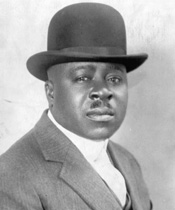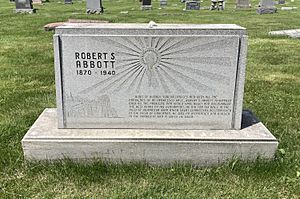Robert Sengstacke Abbott facts for kids
Quick facts for kids
Robert Sengstacke Abbott
|
|
|---|---|

Abbott circa 1919
|
|
| Born | December 24, 1870 St. Simons, Georgia, U.S.
|
| Died | February 29, 1940 (aged 69) Chicago, Illinois, U.S.
|
| Resting place | Lincoln Cemetery (Blue Island, Illinois) |
| Alma mater |
|
| Occupation |
|
| Years active | 1901–1940 |
| Known for | Founder and publisher of The Chicago Defender newspaper and the Bud Billiken Parade and Picnic |
| Spouse(s) |
Helen Thornton Morrison
(m. 1918; div. 1933)Edna Brown Denison
(m. 1934) |
| Relatives | John H. Sengstacke (nephew) Robert A. Sengstacke (great–nephew) |
Robert Sengstacke Abbott (born December 24, 1870 – died February 29, 1940) was an American lawyer and newspaper publisher. He is famous for starting The Chicago Defender in 1905. This newspaper became the most popular Black-owned newspaper in the United States.
Abbott also created the Bud Billiken Parade and Picnic in August 1929. This parade celebrates young people, education, and African-American life in Chicago, Illinois. It is now the second largest parade in the United States.
Contents
Robert Abbott's Early Life
Growing Up in Georgia
Robert Abbott was born on December 24, 1870, in St. Simons, Georgia. His parents had been enslaved before the American Civil War. They became free after the war. Robert's father, Thomas Abbott, died when Robert was a baby.
His mother, Flora Abbott, then married John Sengstacke. John was a mixed-race man who had come to the US from Germany. He treated Robert like his own son. Robert was given the middle name Sengstacke to show he was part of the family.
John Sengstacke was a teacher and a missionary. He wanted to improve education for African Americans. He also started a newspaper called the Woodville Times. He believed in helping people and making things better.
Education and Learning
Robert Abbott studied printing at Hampton Institute in Virginia from 1892 to 1896. This was a special college for Black students. While there, he sang with the Hampton Choir and Quartet, which toured around the country.
He later earned a law degree from Kent College of Law in Chicago in 1898. After finishing law school, Abbott became a Prince Hall Freemason in Chicago.
Robert Abbott's Career
Starting a Law Practice
After becoming a lawyer, Abbott tried to start his own law practice. He worked for a few years in places like Gary, Indiana, and Topeka, Kansas. He then returned to Chicago. He saw many Black people moving to Chicago from the Southern states. This big move was called the Great Migration.
The Chicago Defender Newspaper
In 1905, Robert Abbott started The Chicago Defender newspaper. He began with only 25 cents. He printed the first copies in a room at his boarding house. His landlady encouraged him, and he later bought her a house.
Abbott wanted to help Black people find jobs and get fair treatment. He also wanted to encourage them to leave the segregated South. In the South, Jim Crow laws made life very unfair for Black people. They faced segregation and could not vote.
A big part of the newspaper's success came from railroad porters. These Black men worked on trains and were highly respected. They often sold or gave out the Defender on their train routes.
The Defender's popularity grew very fast:
- By 1916, it sold 50,000 copies.
- By 1918, it sold 125,000 copies.
- By the early 1920s, it sold over 200,000 copies.
The Defender played a huge role in the Great Migration. It became the most widely read Black newspaper in the country. It was known as "America's Black Newspaper." Because of its success, Abbott became one of the first self-made Black millionaires.
The newspaper helped many Black people move from the rural South to big cities in the North. They wanted to find better lives, housing, and schools. The Defender shared stories of people who had already moved North. It gave hope to those who were treated unfairly in the South.
Abbott used his newspaper to encourage people to move. He even set a date, May 15, 1917, for what he called 'The Great Northern Drive'. He showed pictures of Chicago and listed housing ads. He wrote about how much better life could be in the North, describing it as a place of fairness and success.
Goals of The Chicago Defender
Robert Abbott was a strong supporter of rights. He listed nine main goals for the Defender, which he called its "Bible":
- American race prejudice must be destroyed.
- All trade unions should be open to Black people and white people.
- Black people should be in the President's Cabinet.
- Black engineers, firemen, and conductors should be hired on all American railroads and in all government jobs.
- Black people should be in all police forces across the United States.
- Government schools should prefer American citizens over foreigners.
- Black motormen and conductors should be hired on all public transportation.
- There should be a federal law to stop lynching (a form of mob violence).
- All American citizens should have full voting rights.
The Chicago Defender not only encouraged people to move North but also to fight for their rights once they got there. Its main slogan was "American race prejudice must be destroyed." Abbott also published a short magazine called Abbott's Monthly.
The Bud Billiken Parade
Bud Billiken is a made-up character that Robert Abbott created in 1923. During the Great Depression, Abbott used Bud Billiken in the youth section of his newspaper. Bud Billiken became a symbol of pride, happiness, and hope for Black people.
David Kellum, who helped start the newspaper, decided to celebrate this character. In 1929, he and Abbott started the "Bud Billiken Parade." This parade happens every year in Chicago. It is the largest African American parade in the United States. Many famous people, politicians, and business leaders have taken part in it. It is considered the second largest parade in the United States.
Robert Abbott's Faith
In 1912, Robert Abbott met ʻAbdu'l-Bahá, who was the leader of the Baháʼí Faith. Abbott was covering a speech by ʻAbdu'l-Bahá in Chicago. By 1924, Abbott and his wife were attending Baháʼí events.
Abbott was looking for a place where there was no race prejudice. He officially joined the Baháʼí Faith in 1934. He found that their meetings seemed free of prejudice.
Final Years and Legacy
In 1919, the Governor of Illinois, Frank Lowden, asked Abbott to join the Chicago Commission on Race Relations. This group studied the changes happening because of the Great Migration. At one point, 5,000 Black people were arriving in Chicago every week. The Commission gathered information and published a book called The Negro in Chicago.
Robert Abbott died in 1940 in Chicago. He was buried in Lincoln Cemetery in Blue Island, Illinois. He left his newspaper to his nephew, John Henry Sengstacke.
Robert Abbott's Impact
- The Robert S. Abbott House in Chicago, where he lived, became a National Historic Landmark in 1976.
- His childhood home in Savannah, Georgia, was also named a city historic landmark.
- A painting called Robert Abbott Founds the Chicago Defender shows him starting the newspaper.
- Abbott is featured in a TV show called Profiles of African-American Success.
- In 2017, Abbott was honored and added to the Chicago Literary Hall of Fame.
Images for kids



